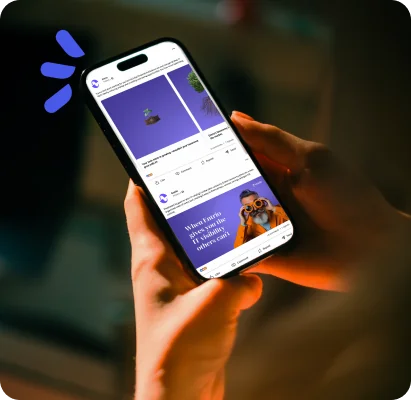
Inbound marketing is one of the most effective ways to bring qualified prospects directly to you.
Why? Because it’s built on attracting customers with valuable content tailored to their needs and interests. Done right, inbound establishes trust, drives engagement, and fuels long-term growth.
But here’s the catch: while inbound is popular, many marketers still stumble on the basics. Misconceptions and mistakes can creep into your strategy, leaving your efforts underperforming. Let’s look at four of the most common mistakes—and how to fix them.
Mistake #1: Basing buyer personas solely on job titles
Why it happens: It feels efficient to reduce your audience to a title—CFO, Marketing Manager, IT Director. Job titles are easy to identify in a database, but they don’t reveal what makes someone tick. They don’t unpack motivations, pain points, or what actually drives decision-making. That’s how you end up with campaigns that technically “hit” the right role but fail to resonate.
Here's the fix: Go beyond titles and build personas around real human factors:
- Roles and responsibilities (what do they actually do day-to-day?)
- Goals and motivations (what are they trying to achieve?)
- Challenges and pain points (what slows them down or keeps them up at night?)
- Personal and professional context (age, education, communication style, even values)
Tools like interviews, surveys, and workshops reveal these details far better than title lists alone.
Your benefit: You’ll create content that resonates with real people, not just job descriptions—guiding them through their buyer’s journey and helping them convert.
Mistake #2: Creating content before selecting target keywords
Why it happens: Crafting content feels like progress—but even the best article won’t deliver results if your audience isn’t searching for it or if search engines can’t understand what it’s about. Too often, marketers write first and optimize later, leaving their content buried under competitors who planned ahead.
Here's the fix: Start every piece with research. Identify target keywords before you write, using tools like SEMrush, Google Keyword Planner, or even AI-driven platforms that surface trending questions. This ensures you’re answering what people are actually asking—not guessing.
But keywords alone aren’t enough anymore. Search engines are changing. With the rise of Generative Engine Optimization (GEO), content must be structured to feed not just Google’s rankings but AI-driven results in tools like ChatGPT and Perplexity. That means:
- Writing clear, authoritative answers to specific questions.
- Using conversational phrasing alongside keywords.
- Structuring content with headers, lists, and direct explanations so AI can easily pull context.
Your benefit: By combining smart keyword planning with GEO best practices, you create content that doesn’t just rank—it’s discoverable across both traditional search engines and emerging AI-powered platforms. The result: more visibility, stronger authority, and an audience that sees you as the trusted source of answers.
Mistake #3: Creating content without promoting it
Why it happens: Many teams assume that publishing content is enough. “If it’s good, people will find it.” The reality? With millions of blogs, videos, and posts going live every day, even the best content can get lost without amplification.
Here's the fix: Promotion has to be baked into your plan, not tacked on at the end. Start with research: where is your audience most active, and what platforms do they trust for professional insights? While LinkedIn is still the leading platform for networking, 43% of internet users say they use social media for work purposes—which means opportunities exist far beyond one channel.
Promote content where your personas spend time:
- LinkedIn for professional communities.
- Email to nurture and educate subscribers.
- Paid ads for precise targeting.
- Secondary platforms like Reddit, YouTube, or industry Slack groups for niche engagement.
Benefit: A content promotion strategy ensures your work reaches the right people at the right time. More eyes on your content means higher engagement, stronger conversions, and measurable ROI.
Mistake #4: Forgetting to market to current customers
Why it happens: Too many teams pour their energy into chasing new customers while neglecting the ones they already have. It feels natural to prioritize acquisition, but ignoring retention is costly. Even after the sale, your customers still need to be delighted and engaged—otherwise, they’ll drift to competitors who invest in building stronger relationships. Retention requires a slightly different playbook, but it’s just as intentional as acquisition.
Here's the fix: Shift part of your inbound strategy toward retention and advocacy by:
- Offering exclusive resources or “insider” content that makes current customers feel valued.
- Using surveys and interviews to shape product or service improvements.
- Creating communities—forums, groups, or events—where customers can connect and share best practices.
- Highlighting and celebrating customer success stories as proof of the value you deliver.
This isn’t just retention—it’s growth. Existing customers are more likely to expand spend and become advocates if they feel valued.
Your benefit: Engaged customers stay longer, refer more often, and provide better quality leads than cold outreach. Investing in retention creates predictable revenue streams and lowers the cost of acquisition in the long run.
The Bottom Line
When you execute inbound marketing with intention, the results speak for themselves:
- Companies that prioritize business blogging are 13x more likely to see positive ROI.
- 40% of marketers say content marketing is a critical part of their overall strategy.
- Buyers consume an average of 3–5 pieces of content before engaging with sales.
- Inbound can double website conversion rates—from 6% to 12%.
Inbound isn’t about publishing for the sake of publishing—it’s about creating the right content, optimizing it for discoverability, promoting it across channels, and nurturing both prospects and customers. Done well, it becomes one of the most reliable growth engines your business can build.Enough talking, let’s get into action. Explore our services and let’s build a plan that drives measurable growth.
Subscribe to our newsletter
Curated content, news articles, team updates and more.



